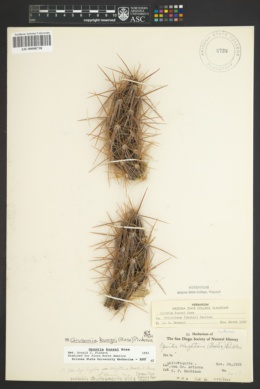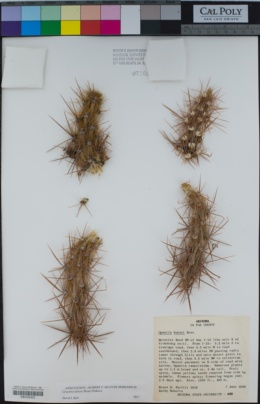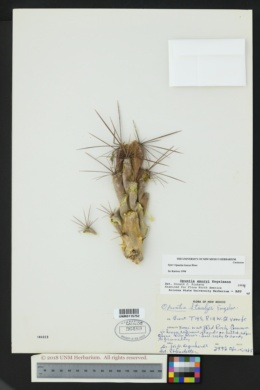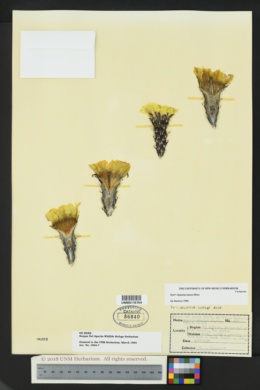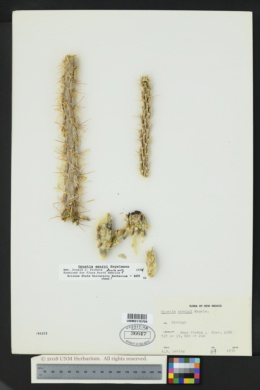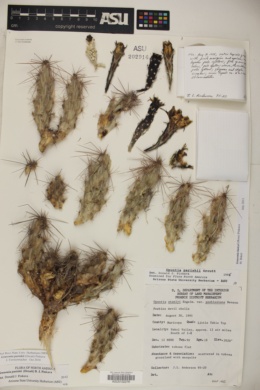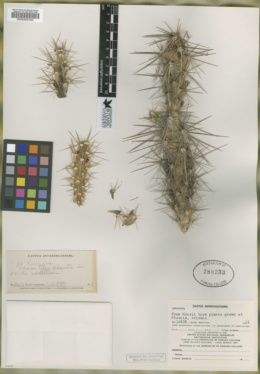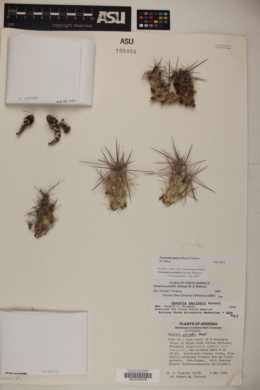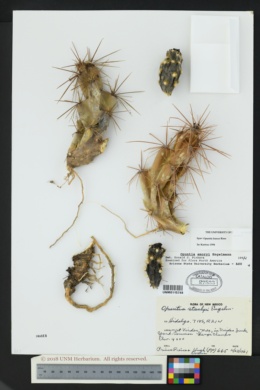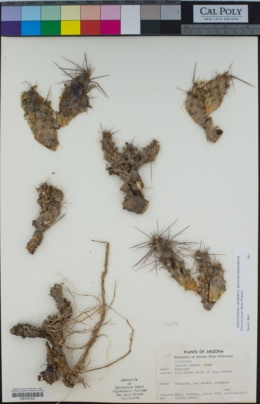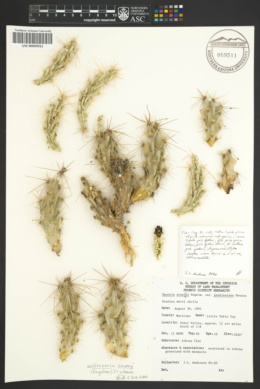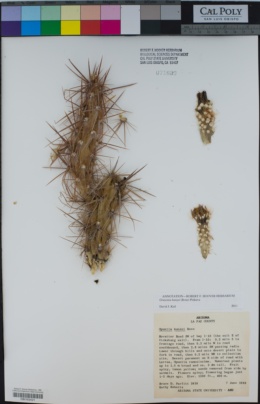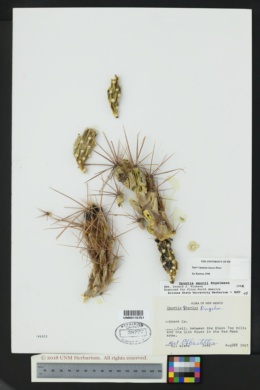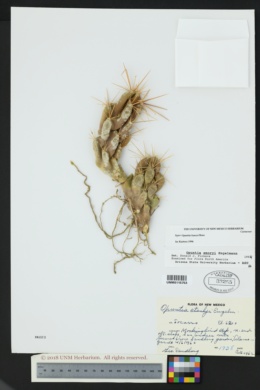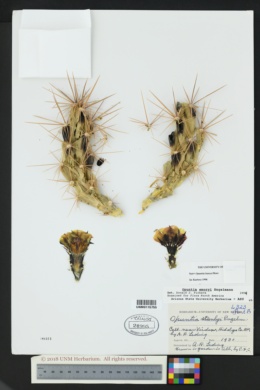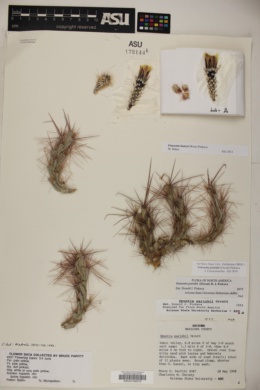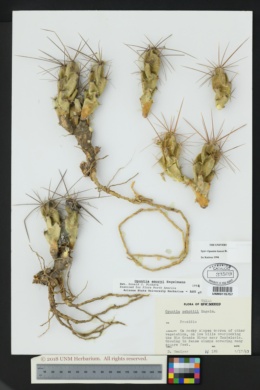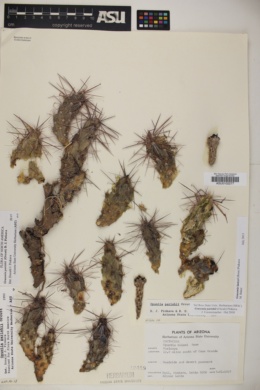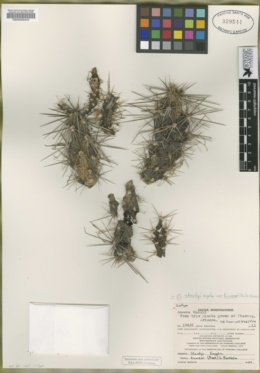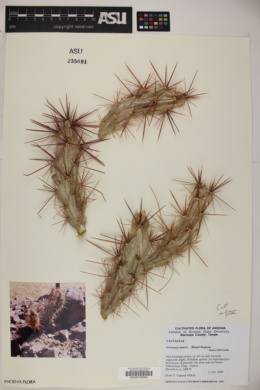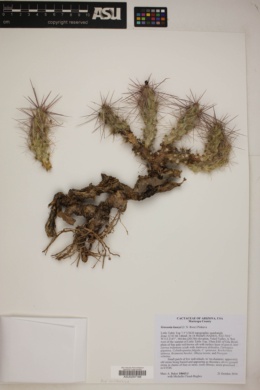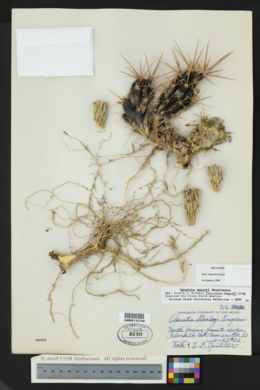Grusonia kunzei
|
|
|
|
Family: Cactaceae
desert club cholla, more...devil's cholla, Kunze's Club-Cholla, dogturd cholla, Desert Club Cholla
[Corynopuntia kunzei (Rose) M.P.Griff., moreOpuntia kunzei Rose, Opuntia stanlyi var. kunzei (Rose) L. Benson, Opuntia stanlyi var. peeblesiana L. Benson, Opuntia wrightiana E.M. Baxter] |
Shrubs, forming mats, to 50 cm, in series of usually 2-4 stem segments. Roots diffuse. Stem segments curved and narrowed at base, 10-15 × 2.5-4 cm; tubercles prominent, 20-30 mm, narrow, 4-6 times longer than wide, obscured by interlacing spines; areoles 5-6 mm in diam.; wool gray-white. Spines 17-27 per areole, ± uniformly distributed along stems; major 4-6 abaxial spines deflexed, tan with whitish margins, strongly flattened, longest to 4.5 cm; major 4-5 adaxial spines divergent, tan to reddish tan, angled at base, longest subterete, to 5 cm. Glochids few in adaxial portion of areole, yellow, 5-6 mm. Flowers: inner tepals yellow to pale yellow-green, to 15-20 mm; filaments white; style light green to white; stigma lobes white. Fruits sometimes proliferating, lemon yellow to yellow, 40-75 × 15-40 mm, fleshy, very spiny, glochidiate; spines (4-)6-17 per areole, straw yellow to brown, 12-20 mm, retrorsely barbed; areoles (40-)45-70. Seeds yellowish white, 4-5 × 3.5-4.5 mm, smooth. 2n = 44. Flowering spring (Apr-Jun). Sonoran Desert, silty, sandy, or gravelly flats and hills; 200-600 m; Ariz.; Mexico (Baja California, Sonora). Plant: Mat-forming shrub, much-branched, to 50 cm tall; STEM segments, curved and narrowed at base, 10-15 cm long, 2.5-4 cm in diam.; tubercles prominent, 2-3 cm long. AREOLES gray-white-felty, subcircular, ca. 5-6 mm in diam Leaves: SPINES well distributed along stems, obscuring them, 17-27 per areole; major 4-5 apical spines tan to reddish tan, divergent, angled at base, the largest subterete, to 5 cm long; major 4-6 basal spines tan with whitish margins, strongly flattened, deflexed, the largest to 4.5 cm long. GLOCHIDS yellow, few in apical part of areole, 5-6 mm long Flowers: inner tepals yellow to pale yellow-green, to 1.5-2 cm long; filaments white; anthers yellow; style light green to white; stigmas white Fruit: lemon-yellow to yellow, fleshy, sometimes proliferating, 4-7.5 cm long, 1.5-4 cm in diam.; glochidiate and spiny, the spines straw-yellow to brown, (4-)6-17 per areole, 12-20 mm long; areoles (40-)45-70. SEEDS yellowish-white, smooth, 4-5 mm long, 3.5-4.5 mm wide Misc: Sonoran Desert, silty, sandy to gravelly flats and hills; 200-600 m (700-1900 ft); Apr-Jun REFERENCES: Pinkava, Donald J. 1999. Cactaceae. Ariz. - Nev. Acad. Sci. 32(1). FNA 2003 Common Name: devil's cholla Duration: Perennial Protected Status: Salvage restricted status in Arizona. General: Mat forming to 50 cm tall with 2-4 stem segments, the segments are curved and narrow at base, 10-15 cm long by 2.5-4 cm diameter with prominent tubercles that are 20-30 mm high and narrow with areoles 5-6 mm diameter, these with gray-white wool. Spines: Spines obscuring the tubercles, usually 17-27 that are uniformly distributed along stem with 4-6 major abaxial spines which are deflexed and tan with whitish margins and strongly flattened with the longest to 4.5 cm, the major adaxial spines are divergent and tan to reddish tan while being angled at the base with the longest to 5 cm, the glochids are yellow and 5-6 mm. Flowers: Inner tepals yellow to pale yellow green and 15-20 mm, the filaments white, and the style light green to white while the stigma lobes are white. Fruits: Fruits sometimes proliferating and lemon yellow, 40-75 mm long by 15-40 mm diameter, they are fleshy and very spiny and glochidate, with 6-17 spines on the fruit that are straw yellow to brown and 12-20 mm long. Ecology: Found on silty, sand, or gravelly flats and hills in the Sonoran Desert from 500-2,000 ft (152-610 m), flowering April-June. Notes: FNA notes that Benson (1969) segregated plants of the southern Arizona populations, and included in the segregation specimens belonging to Grusonia kunzei. G. parishii plants are diploid, with spineless but glochidate fruits, and G. kunzei plants are tetraploid with spiny and glochidate fruits. Grusonias differ from Cylindropuntias by having long tufts of wool on the areoles of the flowers and fruits; and the larger spines are flattened or ribbonlike (Cylindropuntia spines are sometimes flattened but only at the base of the spine) Ethnobotany: Unknown Etymology: Grusonia is named for the German Herman August Jacques Gruson (1821-1895), who had a particular interest in the Cactaceae family, while kunzei is named Richard Ernest Kunze (1838-1919, a German physician who collected around Phoenix in 1900. Synonyms: Opuntia kunzei, Opuntia stanleyi var. kunzei, Opuntia stanleyi var. peeblesiana, Opuntia wrightiana Editor: LCrumbacher 2010 |
|
|
|





























































